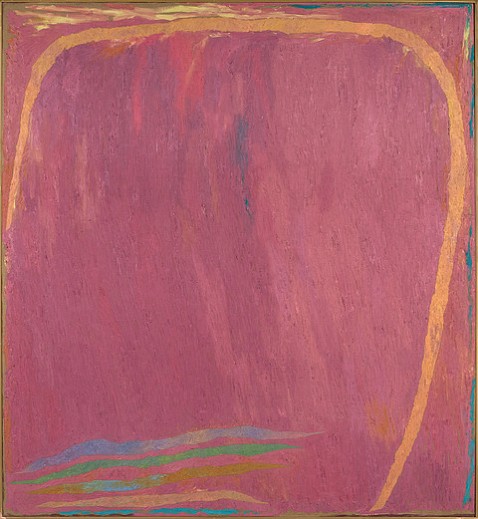
RARELY-SEEN BOXER AT BERRY CAMPBELL
November 24, 2021 - Piri Halsz
Though I've reviewed the paintings of Stanley Boxer (1926 – 2000) many times, mostly it has been his work from the '80s and '90s that I discussed, the pictures covered with glittering, glistering accretions of matière. Only occasionally have I glanced at let alone reviewed his work from the early 1970s, but these are the paintings now featured in "Stanley Boxer: The Ribbon Paintings (1971- 1976)" at Berry Campbell in Chelsea (through December 23). And they form a wonderful chapter in pure painting.
Born in Williamsburg, Brooklyn, Boxer served in the U.S. Navy during World War II, and then studied art at the Art Students League on the G. I. Bill of Rights. He exhibited at various Manhattan galleries from 1953 onward. Still, it doesn't seem to have been until he arrived at Tibor de Nagy in 1971 that some observers began calling him a color-field painter (a designation he always denied, scorning affiliation with any group at all).
According to the brochure essay to the present show by Lisa N. Peters, immediately before 1971, Boxer had been making collages with strips of canvas. A half-way stage may be seen in two of the earlier pictures in this show, most notably "Willowsnowpond" (1972). This good-sized horizontal oil on linen depicts a few totally opaque matte bands of beige wiggling across the perimeters of an equally opaque matte field of dark brown.
Still, other paintings done earlier already boast of more transparent --- and painterly -- layers of paint. "Warmfield" (1971), another and larger square oil on linen, has just such a luminous field of medium green, near whose perimeters stroll vertical arched bands of mustard, olive – and a horizontal one of mauve.
There is something very friendly about these paintings: they do not insist; they invite. And particularly this may be seen by the latest and often largest paintings ranged at the front of the gallery and hung near its entrance, with their loose and ever-more-transparent fields of paint.
To be honest, the subtlety of the brushwork in this series of paintings makes them particularly difficult to appreciate in reproduction. However, the range of tonalities can at least be listed by this correspondent in three cases.
First is the "overmantel" hung above the reception desk. It is titled (in Boxer's characteristic seriocomic portmanteau style) "Seagustglories" (1974), and is a horizontal oil on linen with three horizontal bands, respectively of ocher, lime and mint.
Second is the very tall and narrow "Sunbraid" (1973), also an oil on linen (though there are a few oils on canvas in this show). Hung in the first main gallery space, with its back to the reception desk, "Sunbraid" has a field of mixed orange and lime, upon which is superimposed a soaring, narrow vertical black wiggly line that makes me think of a bird in flight.
Finally and most impressively is "Rainnights" (1973), a large, nearly square vertical oil on linen whose field is a wonderfully mottled raspberry ice. Arched over this field on the top and right-hand side of the canvas wanders a long orange line, while anchoring down the lower left corner are a few short horizontal lines like twigs in cool blues and greens.
If this isn't a very fresh and different kind of color-field painting, it's a kissing cousin to it – so affectionate it is.
Back to News
